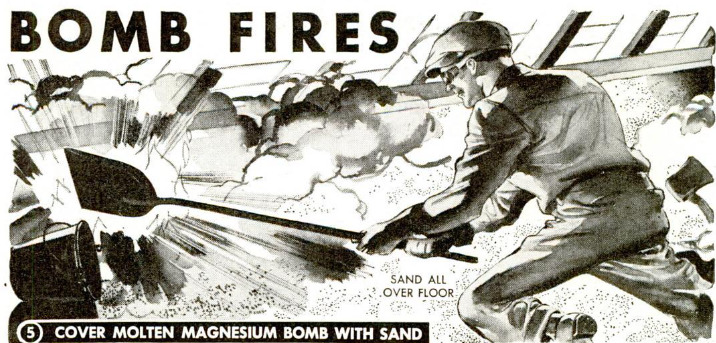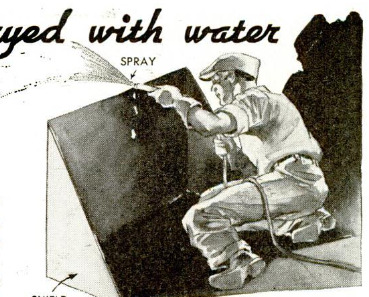ONE thousand 2-lb. incendiary bombs carried by a single plane and dropped on a closely built city will start 166 fires, as it has been found that one out of every six will penetrate a building. When you multiply this by a large number of planes, it is obvious that a city fire department plus auxiliary fire-fighting squads cannot always deal effectively with all fires started, and therefore every householder must be ready and equipped to combat fires in his own or his neighbor’s home in localities where bombing is possible. Dropped from a height of 20,000 ft., small incendiary bombs such as shown in Fig. 7 will pierce any ordinary roof, but as most of the force is spent on such impact, they fall on the top or attic floor. Then the priming charge is ignited, the magnesium casing catches fire with a sputtering action and some white-hot metal is thrown about which ignites inflammable material. If not smothered at once, the intense heat of the molten metal will burn through the second and then the first floors quickly, starting fires at all points, Fig. 2. (The thermit filling of iron oxide and finely divided aluminum develops a tremendous heat of 4,500 degrees.) However, if proper precautions have been taken in advance, and prompt action is taken the moment an ominous thud is heard, a bomb can be smothered. Clearing the attic of inflammable objects and material as in Fig. 1, so that the whole space is instantly accessible, is the first precaution. Next, the roof boards and rafters can be rendered less inflammable if you apply a fire-resistant coating consisting of China clay, 6 Ibs,, and water glass (sodium silicate), 6 Ibs., mixed together thoroughly, and then mixed with water, 2 qts., Fig. 3. Apply this mixture liberally to all exposed wood, making up more as you need it. A heavy coating of whitewash will help somewhat, but ordinary paint is of no value. A fire-resistant floor covering is needed to delay burning through of the molten metal. All joists should be boarded over, and the floor should be covered with a 2%-in. layer of sand, finely sifted earth or ashes, Fig. 4. Other good coverings, which may be used but are relatively expensive, are gypsum blocks and asbestos board, if available. You can also apply a 1-in. layer of ashestos cement topped with a 1-in, layer of sand. Metal is not recommended as a floor cov- ering as it will melt under the intense heat and then help to ignite wood underneath. Sand bags laid on the floor may be too heavy for the floor to support and molten metal can run in between them. After the foregoing precautions have been taken, you should provide the firefighting equipment shown in Fig. 6, near the attic stairs to be available for instant use. Dry sand may be kept in bags, buckets or boxes, small enough to be carried. You can also have a garden hose connected to a hydrant, with the nozzle set to a spray, the hose being coiled up in a convenientlocation. Also, be sure to keep one or more windows of the attic open at all times. Dry sand is used to smother a magnesium bomb that has not started a fire, but if it has already ignited the wood around it or the roof above it, a spray of water is best. Close approach to a burning magnesium bomb for the first minute or so is dangerous as it may contain a delayed explosive charge designed to spread the fire and keep fire fighters away. Also, the normal starting mixture sputters, throwing about a shower of sparks for some distance. Although the intense heat will make close approach impossible, sand or dirt can be thrown on the molten metal with the long-handled, straight-edged shovel as in Fig. 5. Wear dark goggles and leather gloves, and if there is considerable smoke crouch down to keep your head as low as possible. Try to breathe slowly and do not over-exert. Covering the molten metal with sand cuts off the oxygen supply needed for violent burning, and also reduces the heat and the dazzling glare. However, snuffing the bomb with sand does not extinguish it, and it will burn through the floor in a short time. So, immediately after snuffing, scoop it up with the shovel, Fig. 8, (the shovel being covered with sand to protect the metal from melting), and then drop it to the ground through an open window, Fig. 9. If there is no window, drop the bomb into a bucket having at least a 4-in. layer of sand on the bottom, Fig. 10, cover it with more sand, and then carry the bucket outdoors, holding it on the end of the shovel, Fig. 11. Water applied to a magnesium bomb should be sprayed - never directed in a solid stream or by the pailful as this causes an explosion which endangers persons and helps to spread the fire by dispersing the molten metal. Water does not extinguish a magnesium bomb but causes it to burn faster and more intensely so that it will burn itself out in a fraction of the time that it does naturally. Water does extinguish fire started by the bomb and by soaking wood around it, will make it less likely to ignite. When using a hose to spray the bomb and adjacent wood, shield yourself behind a sheet of metal, ashestos board or other flame-resisting material, from a position about 10 or 15 ft. distant. As the regular water supply cannot be depended upon during an air raid, have plenty of water available in the bathtub and in extra vessels. A garden spray can be relied upon when regular water supply fails. One person directs the spray on the bomb, another pumps and replenishes the tank while a third provides extra water, Fig. 12. It takes from 5 to 6 gal. of water to deal with a small magnesium bomb so at least twice this amount should be available. Fire extinguishers having a water base, such as the soda-acid or foam type, are effective but the contents of one (average 2% gal.) is not enough to deal with a bomb. Those having carbon dioxide and carbon tetrachloride are not effective on magnesium bombs, but can be used to put out fire resulting from the bombs. If fire started by a bomb has gained considerable headway, it may be necessary to ignore the bomb itself and start fighting the fire. A small magnesium bomb burns itself out in 15 to 20 min. Where a bomb burns through floors, they should be opened with an ax to be able to apply extinguishing agents around the place where the bomb burned through. Other types of incendiary bombs that the householder should know about are burning thermit bombs, which consist of powdered aluminum and iron oxide. These cannot be extinguished as they do not depend on oxygen to burn. A 10-lb. Thermit bomb burns intensely for about a minute. All that can be done is to try to cool the molten metal with a spray of water, and soak inflammable material nearby. The most commonly used scatter-type incendiary material is white phosphorus, which bursts into flame when exposed to air and produces intense white smoke. “Incendiary leaves” are moist pieces of cardboard or nitrocellulose coated with phosphorus, which ignite when they become dry. Phosphorus does not readily ignite heavy boards but will set fire to shingles, dry grass and other easily combustible materials. Phosphorus bombs are likely to cause more panic than damage, owing to the intense smoke, which is irritating but harmless. The best way to fight phosphorus is to spray it with a concentrated solution of copper sulphate. This forms a thin copper shell around each particle shutting off exposure to air. Water will extinguish it but as soon as the water evaporates, exposure to air again causes it to burn. Phosphorus should be removed outdoors and disposed of by burning, although sometimes small particles can be allowed to burn themselves out if the surrounding inflammable materials are soaked. Great care should be taken as phosphorus causes severe burns on the skin, and it is also poisonous. If an incendiary bomb and the resulting fire cannot be put under control immediately, don't fail to turn in an alarm at once, but keep fighting the fire until help arrives or fire-fighting supplies are exhausted.




